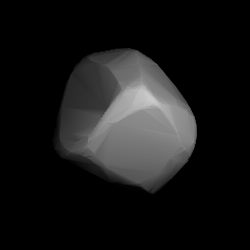Astronomy:1500 Jyväskylä
 Shape model of Jyväskylä from its lightcurve | |
| Discovery[1] | |
|---|---|
| Discovered by | Y. Väisälä |
| Discovery site | Turku Obs. |
| Discovery date | 16 October 1938 |
| Designations | |
| (1500) Jyväskylä | |
| Pronunciation | jyvæs-kylæ |
| Named after | Jyväskylä (Finnish city)[2] |
| 1938 UH | |
| Minor planet category | main-belt · Flora[3] |
| Orbital characteristics[1] | |
| Epoch 4 September 2017 (JD 2458000.5) | |
| Uncertainty parameter 0 | |
| Observation arc | 68.59 yr (25,051 days) |
| |{{{apsis}}}|helion}} | 2.6685 AU |
| |{{{apsis}}}|helion}} | 1.8186 AU |
| 2.2435 AU | |
| Eccentricity | 0.1894 |
| Orbital period | 3.36 yr (1,227 days) |
| Mean anomaly | 172.97° |
| Mean motion | 0° 17m 35.88s / day |
| Inclination | 7.4359° |
| Longitude of ascending node | 19.925° |
| 17.100° | |
| Physical characteristics | |
| Dimensions | 6.63 km (calculated)[3] 7.39±1.59 km[4] 8.088±0.103 km[5] 8.095±0.136 km[6] |
| Rotation period | 8.82750±0.00001 h[7] |
| Geometric albedo | 0.161±0.050[6] 0.1614±0.0254[5] 0.24 (assumed)[3] 0.31±0.13[4] |
| Tholen = S[1] · S[3] B–V = 0.920[1] U–B = 0.520[1] | |
| Absolute magnitude (H) | 12.76[4] · 13.06[1][3][5] |
1500 Jyväskylä (jyvæs-kylæ), provisional designation 1938 UH, is a stony Florian asteroid from the inner regions of the asteroid belt, approximately 7 kilometers in diameter. It was discovered on 16 October 1938, by Finnish astronomer Yrjö Väisälä at the Turku Observatory in Southwest Finland.[8] It was named for the Finnish town Jyväskylä.[2]
Classification and orbit
Jyväskylä is a member of the Flora family, a large collisional group of stony asteroids. It orbits the Sun in the inner main-belt at a distance of 1.8–2.7 AU once every 3 years and 4 months (1,227 days). Its orbit has an eccentricity of 0.19 and an inclination of 7° with respect to the ecliptic.[1] The body's observation arc begins at Turku, 3 weeks prior to its official discovery observation.[8]
Physical characteristics
In 2016, a modeled lightcurve was derived from data contained in the Lowell photometric database. Light-curve analysis gave it a rotation period of 8.8275 hours and a spin axis of (123°, −75.0°) in ecliptic coordinates ({{{1}}}).[7]
According to the survey carried out by NASA's Wide-field Infrared Survey Explorer with its subsequent NEOWISE mission, the asteroid measures between 7.39 and 8.095 kilometers in diameter, and its surface has an albedo between 0.161 and 0.31.[4][5][6] The Collaborative Asteroid Lightcurve Link assumes an albedo of 0.24 – derived from 8 Flora, the largest member and namesake of this family – and calculates a diameter of 6.63 kilometers, using an absolute magnitude of 13.06.[3]
Naming
This minor planet was named for the Finnish town Jyväskylä.[2] It is the largest city in the region of Central Finland and on the Finnish Lakeland. The official naming citation was published by the Minor Planet Center on 20 February 1976 (M.P.C. 3928).[9]
References
- ↑ 1.0 1.1 1.2 1.3 1.4 1.5 1.6 "JPL Small-Body Database Browser: 1500 Jyvaskyla (1938 UH)". Jet Propulsion Laboratory. https://ssd.jpl.nasa.gov/sbdb.cgi?sstr=2001500. Retrieved 30 June 2017.
- ↑ 2.0 2.1 2.2 Schmadel, Lutz D. (2007). "(1500) Jyväskylä". Dictionary of Minor Planet Names – (1500) Jyväskylä. Springer Berlin Heidelberg. p. 119. doi:10.1007/978-3-540-29925-7_1501. ISBN 978-3-540-00238-3.
- ↑ 3.0 3.1 3.2 3.3 3.4 3.5 "LCDB Data for (1500) Jyväskylä". Asteroid Lightcurve Database (LCDB). http://www.minorplanet.info/PHP/generateOneAsteroidInfo.php?AstInfo=1500%7CJyväskylä. Retrieved 4 January 2017.
- ↑ 4.0 4.1 4.2 4.3 Nugent, C. R.; Mainzer, A.; Bauer, J.; Cutri, R. M.; Kramer, E. A.; Grav, T. et al. (September 2016). "NEOWISE Reactivation Mission Year Two: Asteroid Diameters and Albedos". The Astronomical Journal 152 (3): 12. doi:10.3847/0004-6256/152/3/63. Bibcode: 2016AJ....152...63N.
- ↑ 5.0 5.1 5.2 5.3 Mainzer, A.; Grav, T.; Masiero, J.; Hand, E.; Bauer, J.; Tholen, D. et al. (November 2011). "NEOWISE Studies of Spectrophotometrically Classified Asteroids: Preliminary Results". The Astrophysical Journal 741 (2): 25. doi:10.1088/0004-637X/741/2/90. Bibcode: 2011ApJ...741...90M.
- ↑ 6.0 6.1 6.2 Masiero, Joseph R.; Grav, T.; Mainzer, A. K.; Nugent, C. R.; Bauer, J. M.; Stevenson, R. et al. (August 2014). "Main-belt Asteroids with WISE/NEOWISE: Near-infrared Albedos". The Astrophysical Journal 791 (2): 11. doi:10.1088/0004-637X/791/2/121. Bibcode: 2014ApJ...791..121M. http://adsabs.harvard.edu/cgi-bin/bib_query?bibcode=2014ApJ...791..121M. Retrieved 4 January 2017.
- ↑ 7.0 7.1 Durech, J.; Hanus, J.; Oszkiewicz, D.; Vanco, R. (March 2016). "Asteroid models from the Lowell photometric database". Astronomy and Astrophysics 587: 6. doi:10.1051/0004-6361/201527573. Bibcode: 2016A&A...587A..48D. http://adsabs.harvard.edu/cgi-bin/bib_query?bibcode=2016A&A...587A..48D. Retrieved 4 January 2017.
- ↑ 8.0 8.1 "1500 Jyvaskyla (1938 UH)". Minor Planet Center. https://www.minorplanetcenter.net/db_search/show_object?object_id=1500. Retrieved 4 January 2017.
- ↑ Schmadel, Lutz D. (2009). "Appendix – Publication Dates of the MPCs". Dictionary of Minor Planet Names – Addendum to Fifth Edition (2006–2008). Springer Berlin Heidelberg. p. 221. doi:10.1007/978-3-642-01965-4. ISBN 978-3-642-01964-7. Bibcode: 2009dmpn.book.....S.
External links
- Asteroid Lightcurve Database (LCDB), query form (info )
- Dictionary of Minor Planet Names, Google books
- Asteroids and comets rotation curves, CdR – Observatoire de Genève, Raoul Behrend
- Discovery Circumstances: Numbered Minor Planets (1)-(5000) – Minor Planet Center
- 1500 Jyväskylä at AstDyS-2, Asteroids—Dynamic Site
- 1500 Jyväskylä at the JPL Small-Body Database
 |

